Chemically Reactive Micropolar Hybrid Nanofluid Flow over a Porous Surface in the Presence of an Inclined Magnetic Field and Radiation with Entropy Generation
Abstract
1. Introduction
2. Model, Key Equations, and Solutions
2.1. Restrictions and Assumptions
- Considered is an incompressible ferro-hybrid nanofluid with laminar flow.
- Considered are thermal radiation, heat source/sink, chemical reaction and Joule heating effects.
- Considered is a Newtonian base fluid water with magnetic oxide (Fe3O4) and cupric oxide (CuO) nanoparticles immersed.
- The flow is organized by the stretching of the surface, and with a negligible term of pressure gradient i.e., .
- Assumed is steady incompressible movement, i.e., , where u is the velocity and t denotes the time.
- Assumed is a surface stretching velocity .
2.2. Governing Equations
2.3. Boundary Conditions (BCs)
2.4. Similarity Transformation
3. Solution of the Velocity Equation
4. Analytic Solution for the Temperature Equation
5. Analytic Solution for the Concentration Equation
6. Entropy Generation Analysis
7. Results and Discussion
8. Conclusions
- Increasing the porosity parameter decreases the axial and angular velocities profiles.
- Increasing the micropolar parameter causes axial and angular velocities increases.
- As the magnetic field increases, axial as well as angular velocities decrease, while the temperature of the PST and PHF cases increases, and the Nusselt number and entropy generation decrease.
- Increasing the mass transpiration causes axial and angular velocities decrease.
- Increasing the Magnetic field raises the skin friction.
- Increasing the thermal diffusivity increases the skin friction.
- Increasing the Brinkman number decreases the axial and angular velocities.
- Increasing the Nr parameter increases the temperature for the PST and PHF cases, and the entropy production.
- As the Brickman number increases, the entropy production increases.
Author Contributions
Funding
Data Availability Statement
Conflicts of Interest
References
- Raghunath, K.; Gulle, N.; Vaddemani, R.R.; Mopuri, O. Unsteady MHD fluid flow past an inclined vertical porous plate in the presence of chemical reaction with aligned magnetic field, radiation, and Soret effects. Heat Transf. 2022, 51, 2742–2760. [Google Scholar] [CrossRef]
- Li, Z.; Li, K.; Guo, X.; Gao, X.; Dai, W.; Gong, M.; Shen, J. Influence of timing between magnetic field and fluid flow in a rotary magnetic refrigerator. Appl. Therm. Engin. 2021, 187, 116477. [Google Scholar] [CrossRef]
- Zhang, X.; Zhang, Y. Experimental study on enhanced heat transfer and flow performance of magnetic nanofluids under alternating magnetic field. Int. J. Therm. Sci. 2021, 164, 106897. [Google Scholar] [CrossRef]
- Vinod, Y.; Nagappanavar, S.N.; Raghunatha, K.R.; Sangamesh. Dufour and Soret effects on double diffusive Casson fluid flow with the influence of internal heat source. J. Umm Al-Qura Univ. Appl. Sci. 2024, in print. [CrossRef]
- Qi, L.; Zhang, Q.; Niu, S.; Chen, R.; Li, Y. Influencing mechanism of an external magnetic field on fluid flow, heat transfer and microstructure in aluminum resistance spot welding. Engin. Appl. Comput. Fluid Mech. 2021, 15, 985–1001. [Google Scholar] [CrossRef]
- Ige, E.O.; Oyelami, F.H.; Adedipe, E.S.; Tlili, I.; Khan, M.I.; Khan, S.U.; Malik, M.Y.; Xia, W.F. Analytical simulation of nanoparticle-embedded blood flow control with magnetic field influence through spectra homotopy analysis method. Int. J. Mod. Phys. B 2021, 35, 2150226. [Google Scholar] [CrossRef]
- Teng, B.; Luo, W.; Chen, Z.; Kang, B.; Chen, L.; Wang, T. A comprehensive study of the effect of Brinkman flow on the performance of hydraulically fractured wells. J. Petrol. Sci. Engin. 2022, 213, 110355. [Google Scholar] [CrossRef]
- Zhang, L.; Bhatti, M.M.; Michaelides, E.E. Electro-magnetohydrodynamic flow and heat transfer of a third-grade fluid using a Darcy–Brinkman–Forchheimer model. Int. J. Numer. Meth. Heat Fluid Flow 2021, 31, 2623–2639. [Google Scholar] [CrossRef]
- El-Sapa, S. Effect of permeability of Brinkman flow on thermophoresis of a particle in a spherical cavity. Eur. J. Mech. B Fluids 2020, 79, 315–323. [Google Scholar] [CrossRef]
- Sachhin, S.M.; Mahabaleshwar, U.S.; Laroze, D.; Drikakis, D. Darcy–Brinkman model for ternary dusty nanofluid flow across stretching/shrinking surface with suction/injection. Fluids 2024, 9, 94. [Google Scholar] [CrossRef]
- Li, H.; Wang, S.; Wang, R.; Liu, Y.; Shao, B.; Yuan, Z.; Chen, Y.; Ma, Y. Simulation on flow behavior of particles and its effect on heat transfer in porous media. J. Petrol. Sci. Engin. 2021, 197, 107974. [Google Scholar] [CrossRef]
- Wang, C.; Zheng, X.; Zhang, T.; Chen, H.; Mobedi, M. The effect of porosity and number of unit cell on applicability of volume average approach in closed cell porous media. Int. J. Numer. Meth. Heat Fluid Flow 2022, 32, 2778–2798. [Google Scholar] [CrossRef]
- Feng, Q.; Cha, L.; Dai, C.; Zhao, G.; Wang, S. Effect of particle size and concentration on the migration behavior in porous media by coupling computational fluid dynamics and discrete element method. Powder Technol. 2020, 360, 704–714. [Google Scholar] [CrossRef]
- Zhang, J.; Zhang, H.; Lee, D.; Ryu, S.; Kim, S. Study on the effect of pore-scale heterogeneity and flow rate during repetitive two-phase fluid flow in microfluidic porous media. Petrol. Geosci. 2021, 27, 2020–2062. [Google Scholar] [CrossRef]
- Sachhin, S.M.; Mahabaleshwar, U.S.; Nayakar, S.N.R.; Patil, H.S.R.; Souayeh, B. Darcy–Brinkman model for Boussinesq–Stokes suspension tetra dusty nanofluid flow over stretching/shrinking sheet with suction/injection. Numer. Heat Transf. A Appl. 2024, in print. [CrossRef]
- Tsiberkin, K. Porosity effect on the linear stability of flow overlying a porous medium. Eur. Phys. J. E 2020, 43, 34. [Google Scholar] [CrossRef] [PubMed]
- Sachhin, S.M.; Mahabaleshwar, U.S.; Zeidan, D.; Joo, S.W.; Manca, O. An effect of velocity slip and MHD on Hiemenz stagnation flow of ternary nanofluid with heat and mass transfer. J. Therm. Anal. Calorim. 2024, in print. [CrossRef]
- Sangamesh; Vinod, Y.; Waqas, H.; Raghunatha, K.R.; Nagappanavar, S.N. Mixed convection over an exponentially stretching surface with the effect of radiation and reaction. Nano. 2024, in print. [CrossRef]
- Li, S.; Raghunath, K.; Alfaleh, A.; Ali, F.; Zaib, A.; Khan, M.I.; Iljaz Khan, M.; Puneeth, V. Effects of activation energy and chemical reaction on unsteady MHD dissipative Darcy–Forchheimer squeezed flow of Casson fluid over horizontal channel. Sci. Rep. 2023, 13, 2666. [Google Scholar] [CrossRef]
- Zhang, L.; Bhatti, M.M.; Shahid, A.; Ellahi, R.; Bég, O.A.; Sait, S.M. Nonlinear nanofluid fluid flow under the consequences of Lorentz forces and Arrhenius kinetics through a permeable surface: A robust spectral approach. J. Taiwan Inst. Chem. Engin. 2021, 124, 98–105. [Google Scholar] [CrossRef]
- Ibrahim, W.; Negera, M. MHD slip flow of upper-convected Maxwell nanofluid over a stretching sheet with chemical reaction. J. Egypt. Math. Soc. 2020, 28, 7. [Google Scholar] [CrossRef]
- Xiong, P.Y.; Chu, Y.M.; Khan, M.I.; Khan, S.A.; Abbas, S.Z. Entropy optimized Darcy–Forchheimer flow of Reiner–Philippoff fluid with chemical reaction. Comput. Theor. Chem. 2021, 1200, 113222. [Google Scholar] [CrossRef]
- Ali, L.; Ali, B.; Liu, X.; Ahmed, S.; Shah, M.A. Analysis of bio-convective MHD Blasius and Sakiadis flow with Cattaneo–Christov heat flux model and chemical reaction. Chin. J. Phys. 2022, 77, 1963–1975. [Google Scholar] [CrossRef]
- Roy, A.K.; Bég, O.A. Mathematical modelling of unsteady solute dispersion in two-fluid (micropolar–Newtonian) blood flow with bulk reaction. Int. Commun. Heat Mass Transf. 2021, 122, 105169. [Google Scholar] [CrossRef]
- Kocić, M.; Stamenković, Ž.; Petrović, J.; Bogdanović–Jovanović, J. MHD micropolar fluid flow in porous media. Adv. Mech. Engin. 2023, 15, 16878132231178436. [Google Scholar] [CrossRef]
- Ali, L.; Liu, X.; Ali, B.; Mujeed, S.; Abdal, S.; Mutahir, A. The impact of nanoparticles due to applied magnetic dipole in micropolar fluid flow using the finite element method. Symmetry 2020, 12, 520. [Google Scholar] [CrossRef]
- Deo, S.; Maurya, D.K.; Filippov, A.N. Effect of magnetic field on hydrodynamic permeability of biporous membrane relative to micropolar liquid flow. Colloid J. 2021, 83, 662–675. [Google Scholar] [CrossRef]
- Raghunatha, K.R.; Vinod, Y.; Nagappanavar, S.N.; Sangamesh. Unsteady Casson fluid flow on MHD with an internal heat source. J. Taibah Univ. Sci. 2023, 17, 2271691. [Google Scholar] [CrossRef]
- Maurya, D.K.; Deo, S.; Khanukaeva, D.Y. Analysis of Stokes flow of micropolar fluid through a porous cylinder. Math. Meth. Appl. Sci. 2021, 44, 6647–6665. [Google Scholar] [CrossRef]
- Vajravelu, K.; Hadjinicolaou, A. Heat transfer in a viscous fluid over a stretching sheet with viscous dissipation and internal heat generation. Int. Commun. Heat Mass Transf. 1993, 20, 417–430. [Google Scholar] [CrossRef]
- Sachhin, S.M.; Mahabaleshwar, U.S.; Chan, A. Effect of slip and thermal gradient on micropolar nano suspension flow across a moving hydrogen fuel-cell membrane. Int. J. Hydrogen Energy 2024, 63, 59–81. [Google Scholar] [CrossRef]
- Gireesha, B.J.; Mahanthesh, B.; Gorla, R.S.R. Suspended particle effect on nanofluid boundary layer flow past a stretching surface. J. Nanofl. 2014, 3, 267–277. [Google Scholar] [CrossRef]
- Singh, P.K.; Anoop, K.B.; Sundararajan, T.; Das, S.K. Entropy generation due to flow and heat transfer in nanofluids. Int. J. Heat Mass Transf. 2010, 53, 4757–4767. [Google Scholar] [CrossRef]
- Srinivasacharya, D.; Hima Bindu, K. Entropy generation in a micropolar fluid flow through an inclined channel. Alexandr. Engin. J. 2016, 55, 973–982. [Google Scholar] [CrossRef]
- Avramenko, A.A.; Tyrinov, A.I.; Shevchuk, I.V.; Dmitrenko, N.P. Dean instability of nanofluids with radial temperature and concentration non-uniformity. Phys. Fluids 2016, 28, 034104. [Google Scholar] [CrossRef]
- Avramenko, A.A.; Shevchuk, I.V.; Abdallah, S.; Blinov, D.G.; Harmand, S.; Tyrinov, A.I. Symmetry analysis for film boiling of nanofluids on a vertical plate using a nonlinear approach. J. Mol. Liq. 2016, 223, 156–164. [Google Scholar] [CrossRef]
- Sajid, M.; Ahmad, I.; Hayat, T.; Ayub, M. Unsteady flow and heat transfer of a second-grade fluid over a stretching sheet. Commun. Nonlinear Sci. Numer. Simul. 2009, 14, 96–108. [Google Scholar] [CrossRef]
- Ishak, A.; Nazar, R.; Pop, I. Heat transfer over a stretching surface with variable heat flux in micropolar fluids. Phys. Lett. A 2008, 372, 559–561. [Google Scholar] [CrossRef]
- Ishak, A.; Nazar, R.; Pop, I. Mixed convection boundary layers in the stagnation-point flow toward a stretching vertical sheet. Meccanica 2006, 41, 509–518. [Google Scholar] [CrossRef]
- Nazar, R.; Amin, N.; Filip, D.; Pop, I. Stagnation point flow of a micropolar fluid towards a stretching sheet. Int. J. Non-Linear Mech. 2004, 39, 1227–1235. [Google Scholar] [CrossRef]
- Crane, L.J. Flow past a stretching plate. Math. Phys. 1970, 21, 645–647. [Google Scholar] [CrossRef]
- Pavlov, K.B. Magnetohydrodynamic flow of incompressible viscous fluid caused by of a surface. Magnetohydrodyn. 1974, 10, 507–510. Available online: http://www.mhd.sal.lv/contents/1974/4/MG.10.4.23.R.html (accessed on 10 November 2024).
- Khan, U.; Zaib, A.; Ishak, A.; Roy, N.C.; Bakar, S.A.; Muhammad, T.; Aty, A.H.A.; Yahia, I.S. Exact solutions for MHD axisymmetric hybrid nanofluid flow and heat transfer over a permeable non-linear radially shrinking/stretching surface with mutual impacts of thermal radiation. Eur. Phys. J. Spec. Top. 2022, 231, 1195–1204. [Google Scholar] [CrossRef]
- Haq, R.U.; Raza, A.; Algehyne, E.A.; Tlili, I. Dual nature study of convective heat transfer of nanofluid flow over a shrinking surface in a porous medium. Int. Commun. Heat Mass Transf. 2020, 114, 104583. [Google Scholar] [CrossRef]
- Elsaid, E.M.; Abdel-Wahed, M.S. MHD mixed convection Ferro Fe3O4/Cu-hybrid-nanofluid runs in a vertical channel. Chin. J. Phys. 2022, 76, 269–282. [Google Scholar] [CrossRef]
- Zaib, A.; Khan, U.; Shah, Z.; Kumam, P.; Thounthong, P. Optimization of entropy generation in flow of micropolar mixed convective magnetite (Fe3O4) ferroparticle over a vertical plate. Alexandr. Engin. J. 2019, 58, 1461–1470. [Google Scholar] [CrossRef]

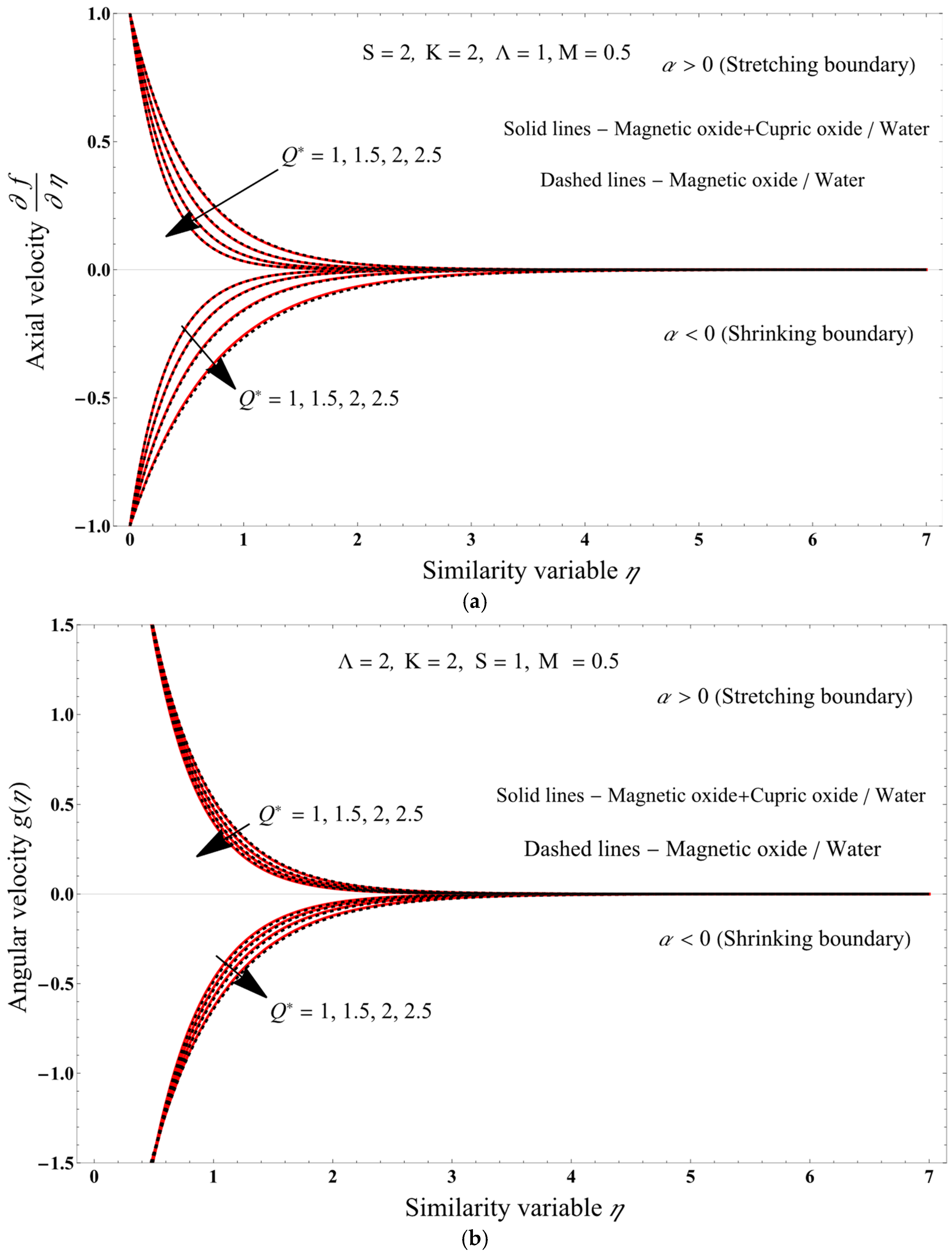
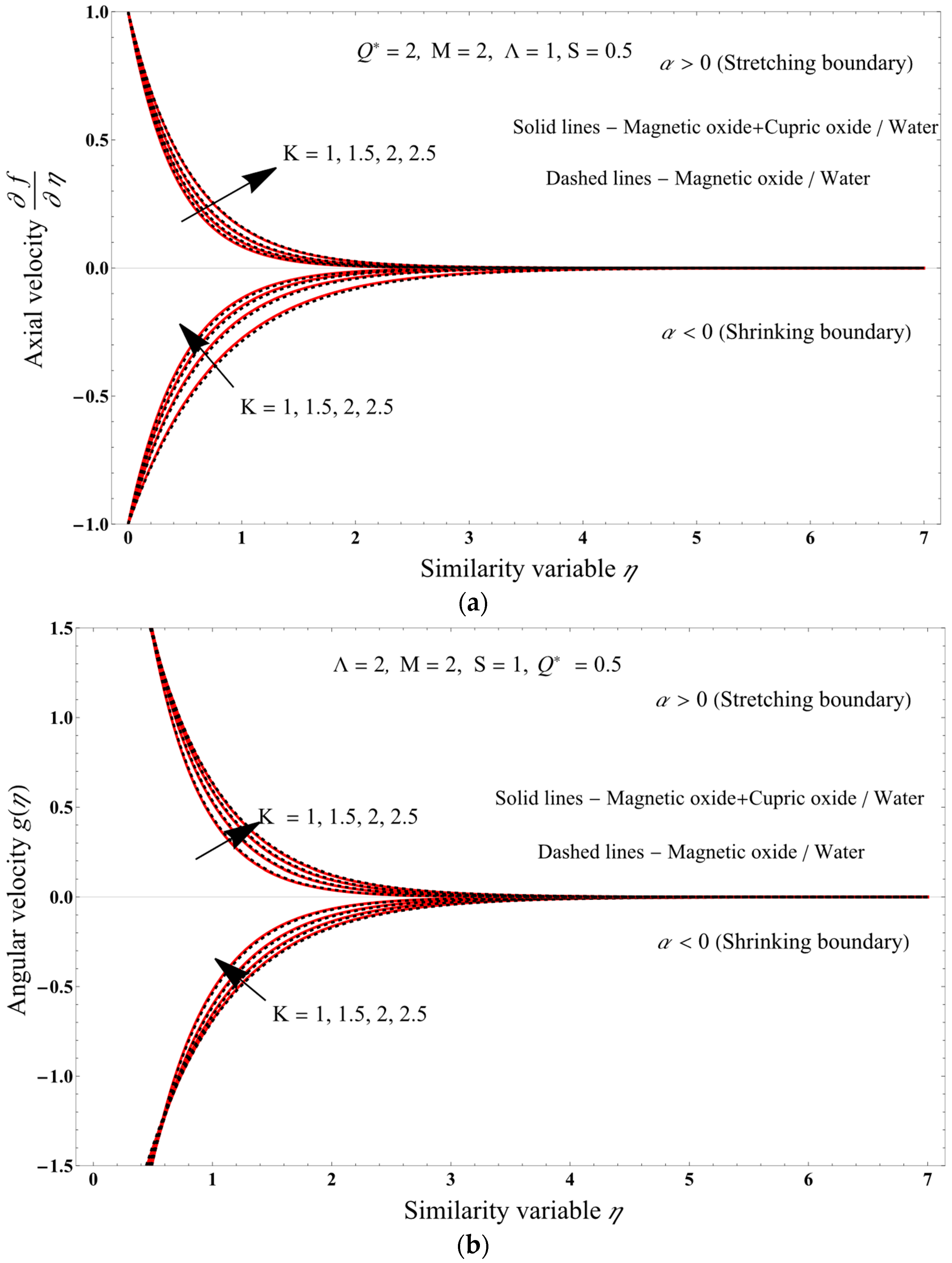
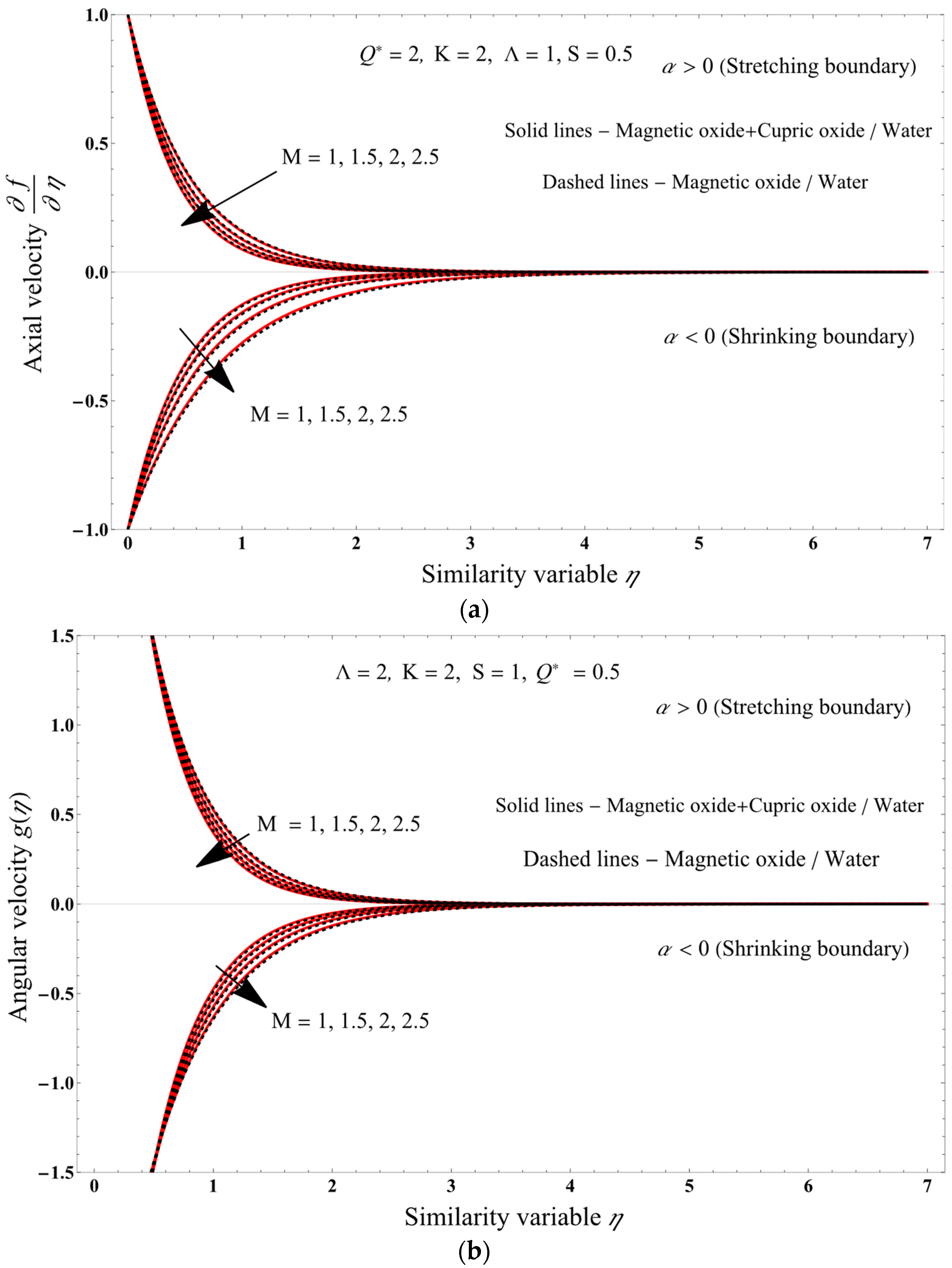
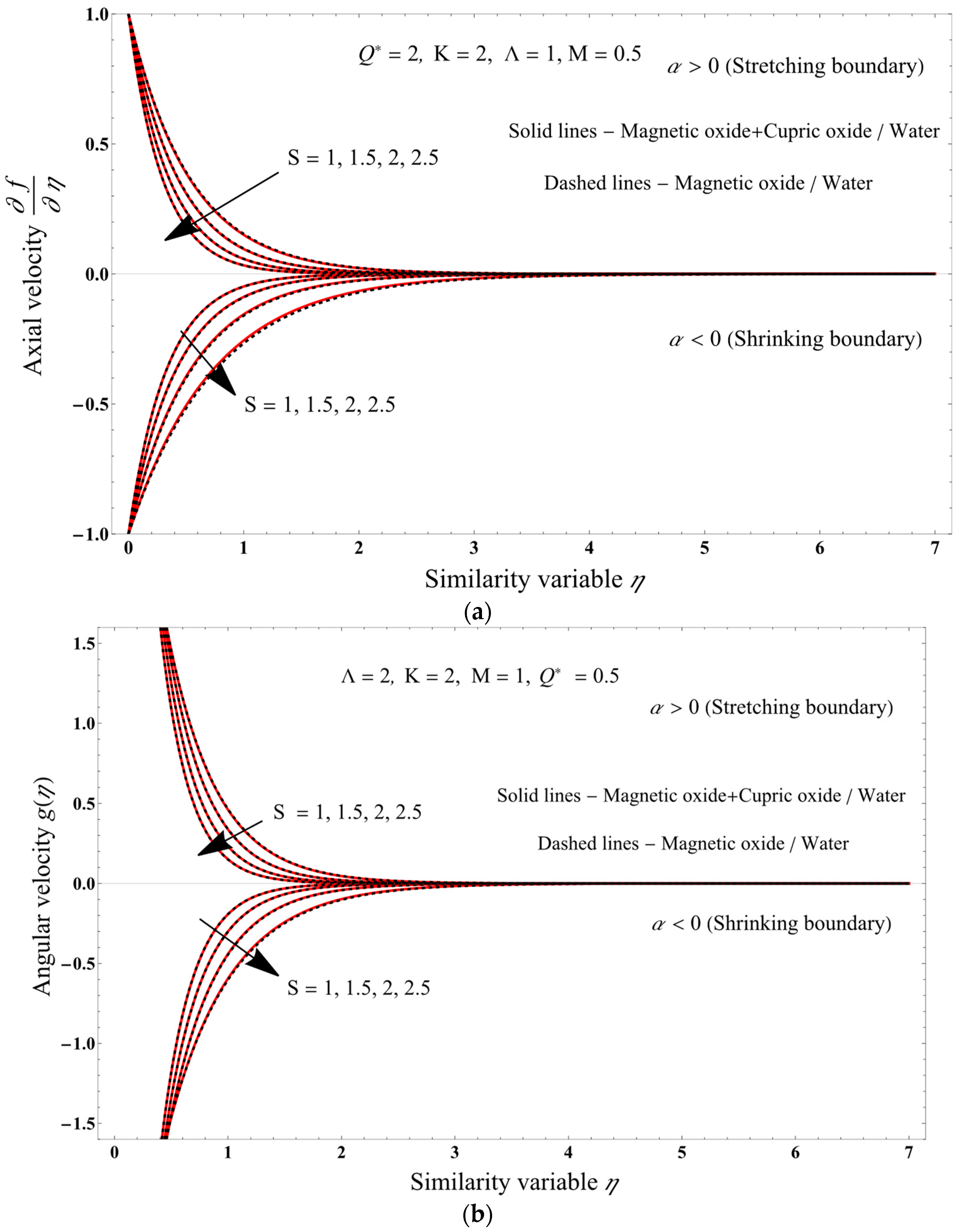
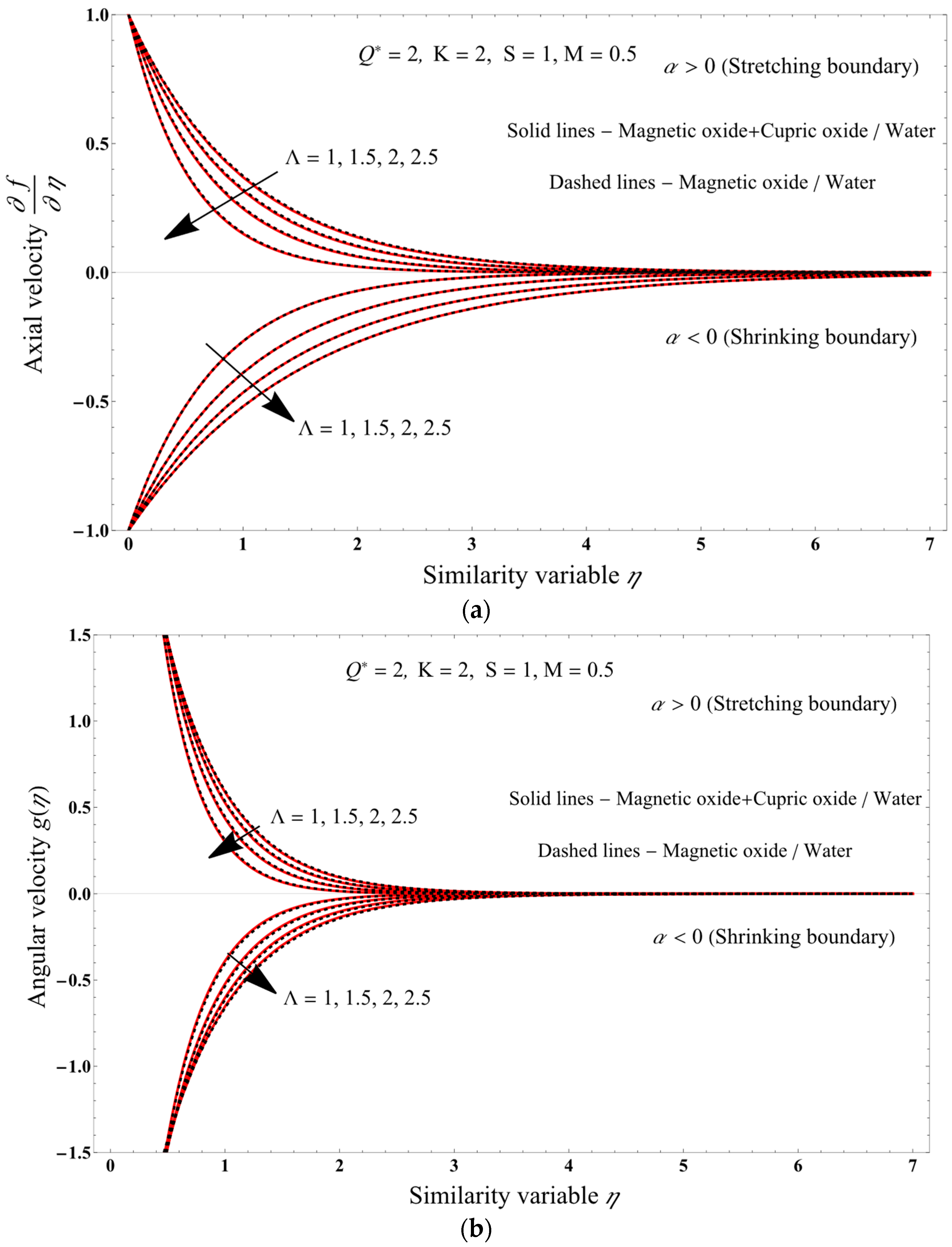

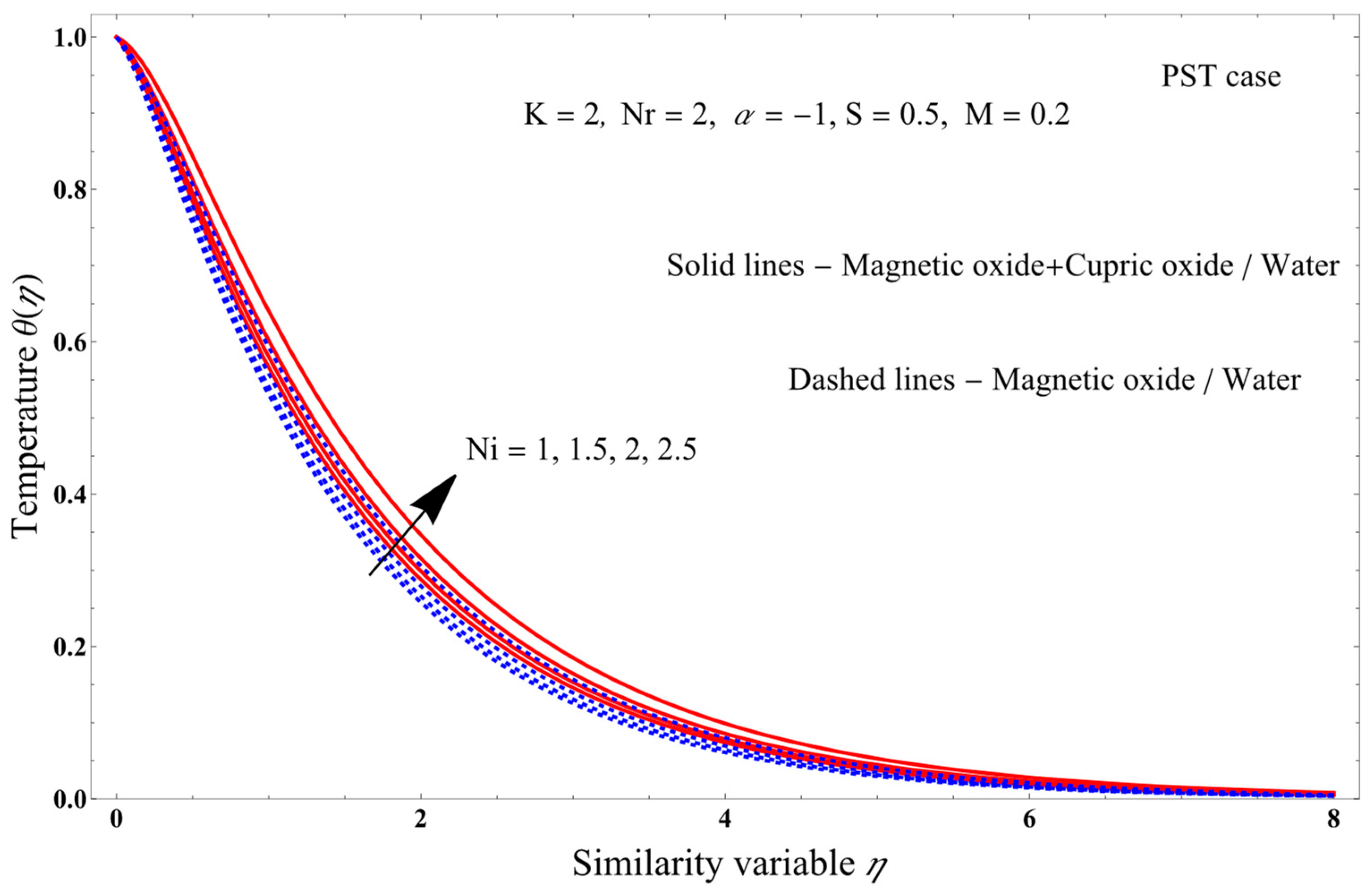
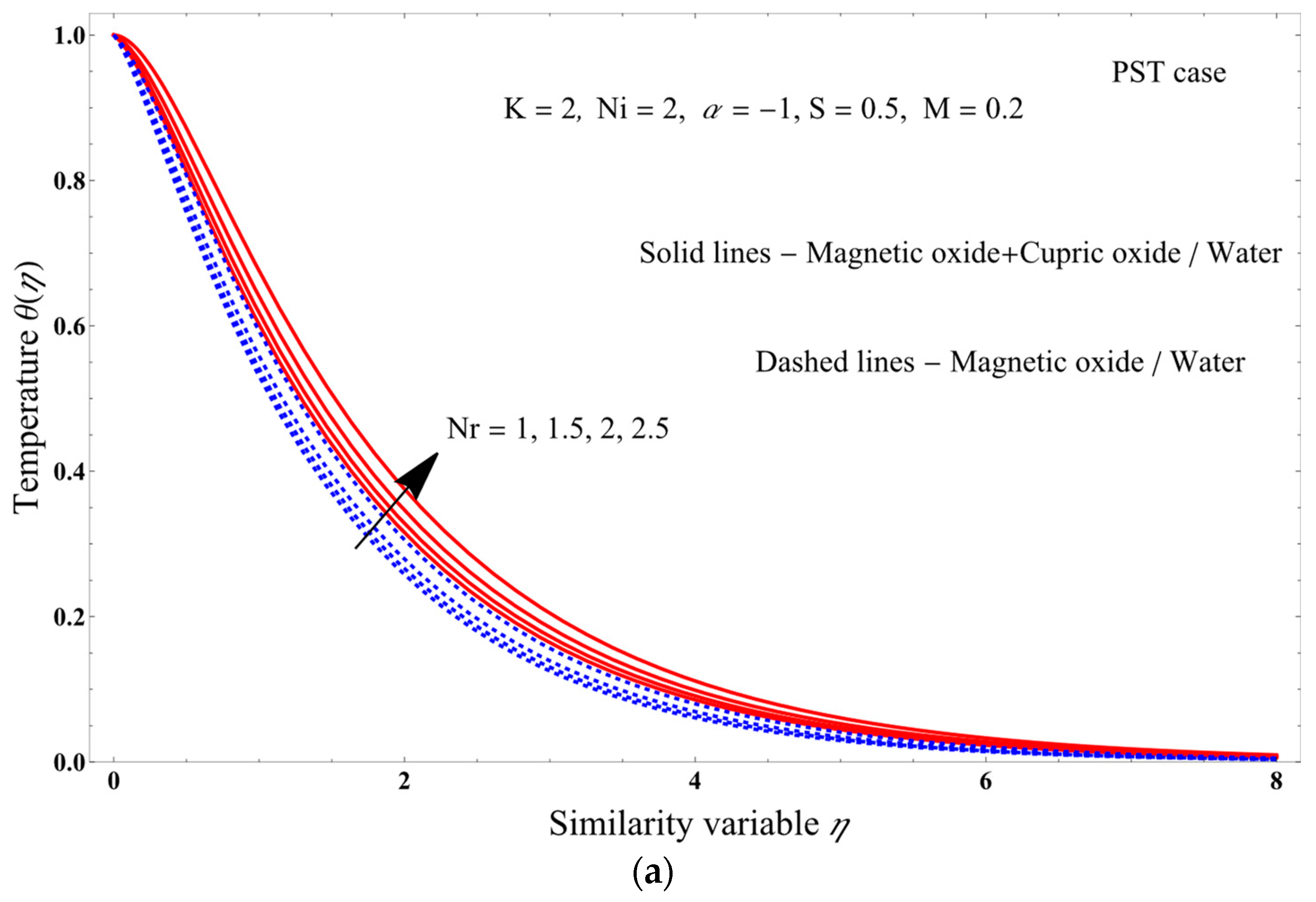
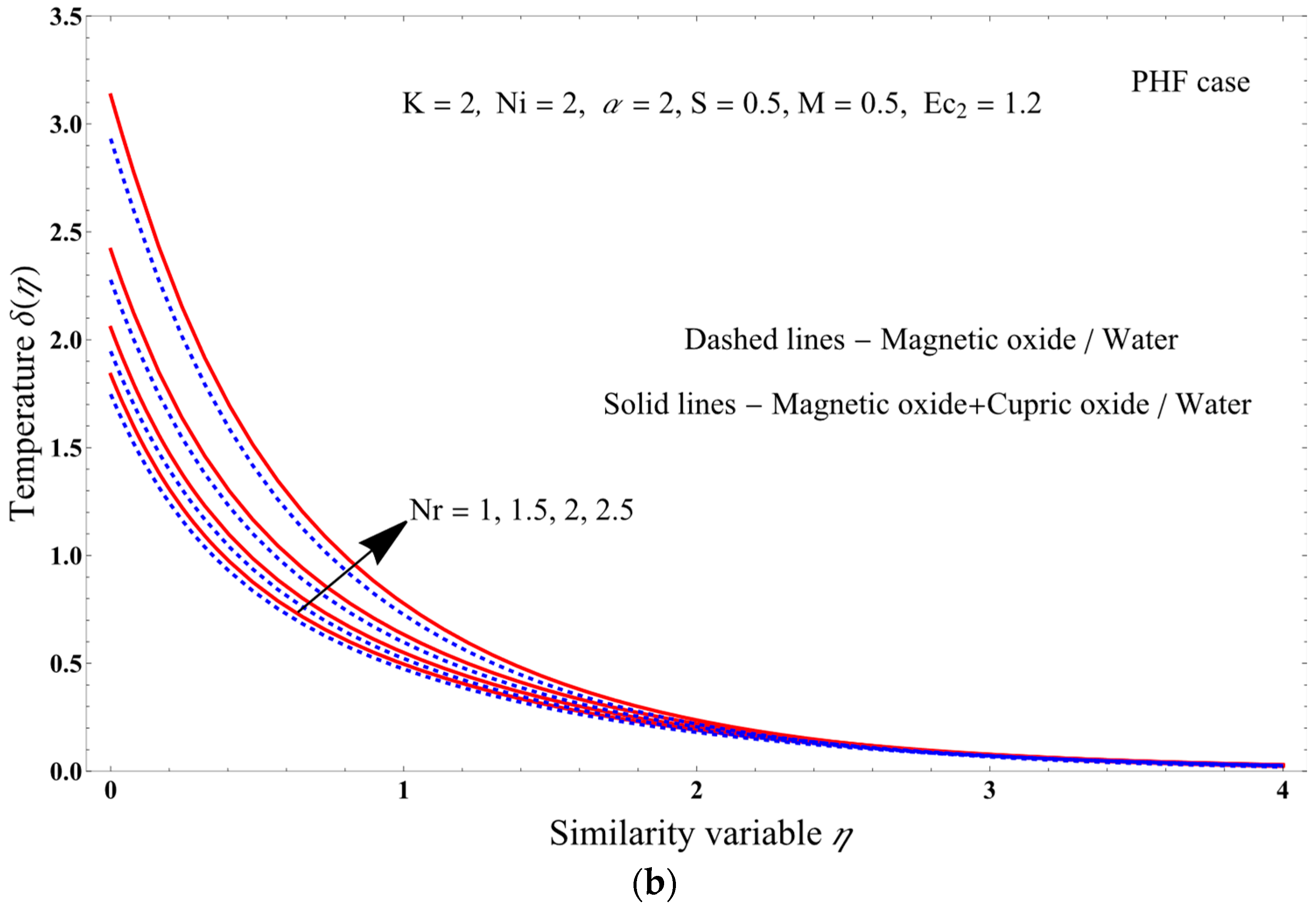
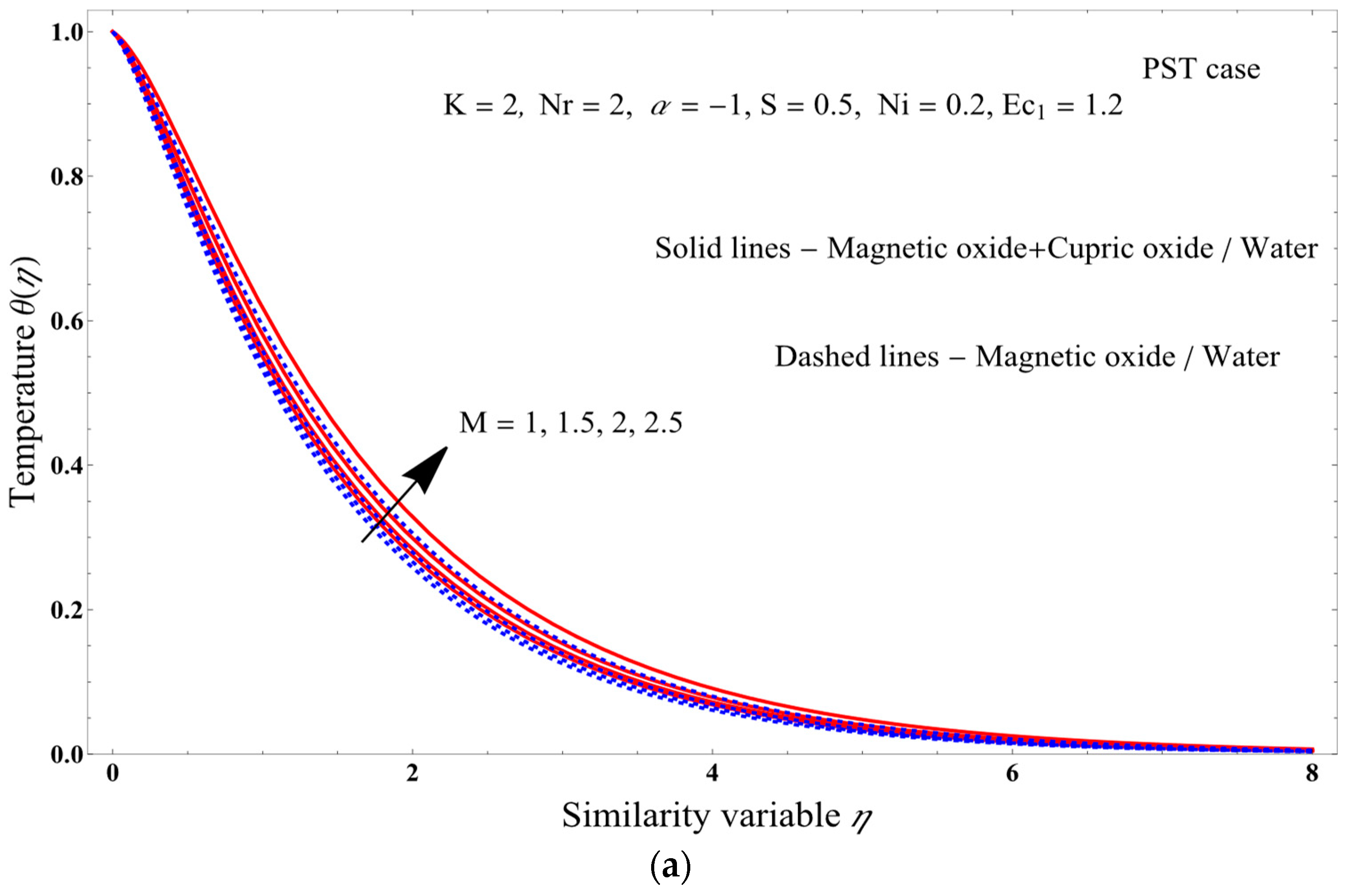

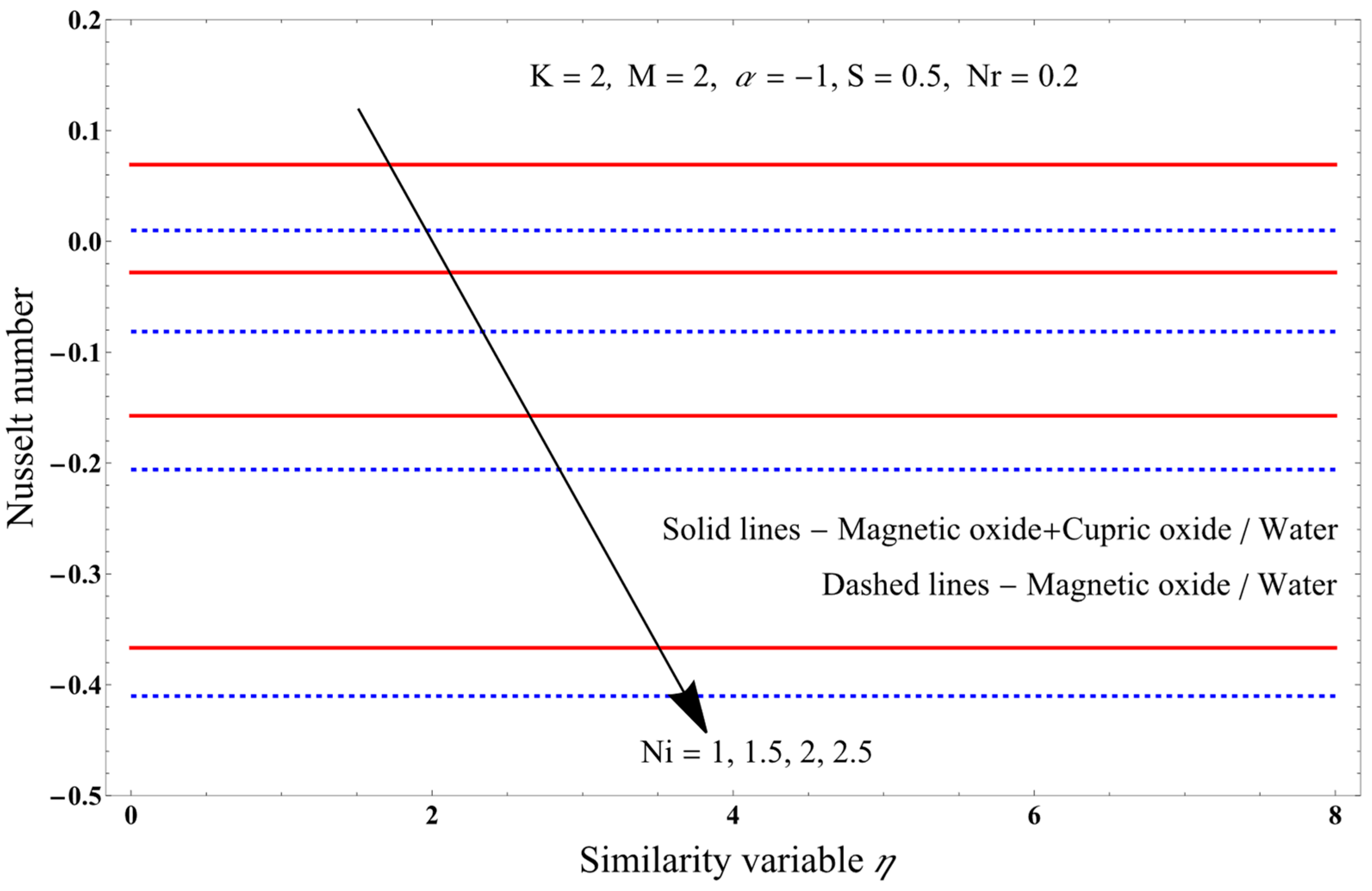


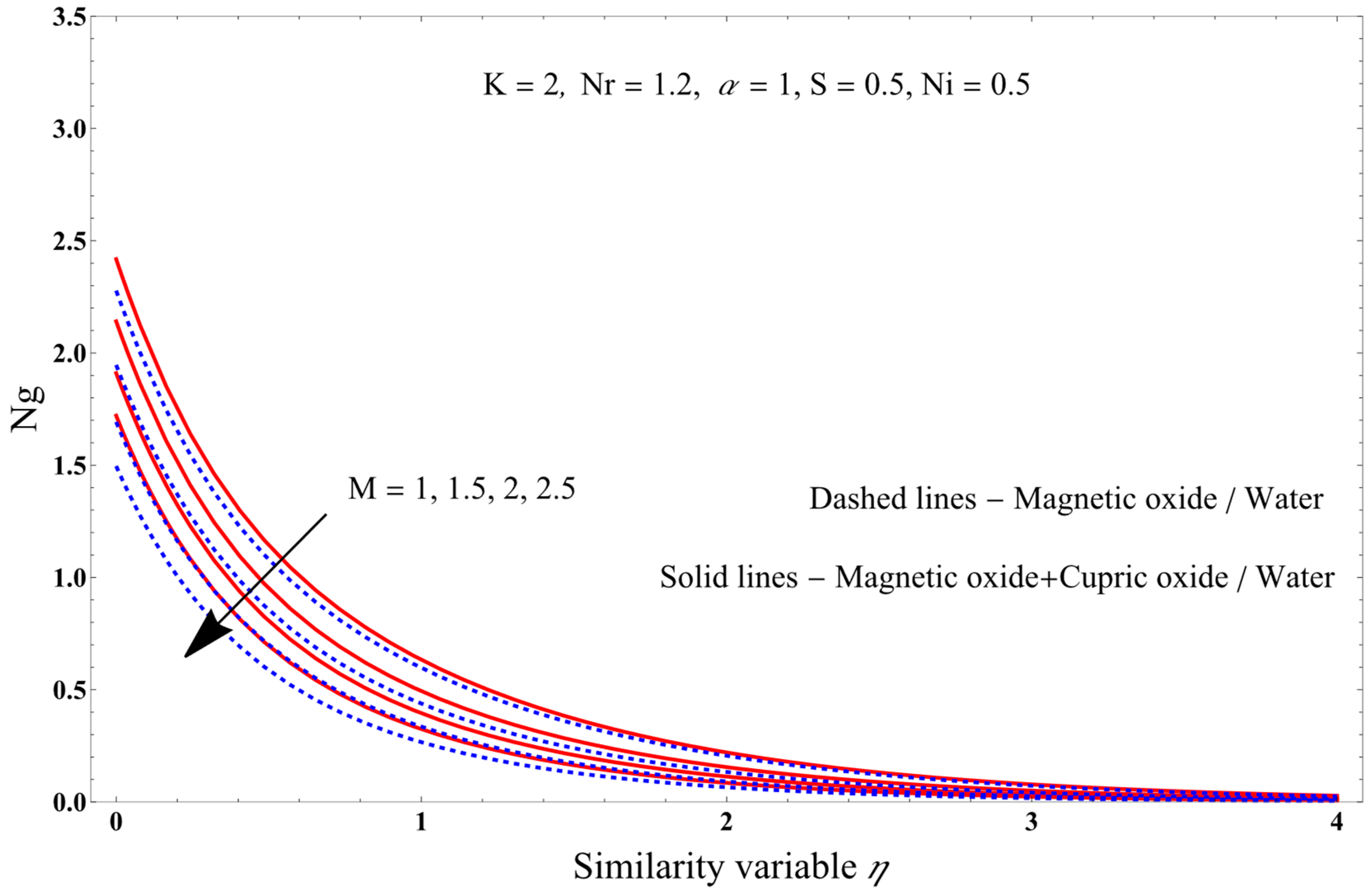
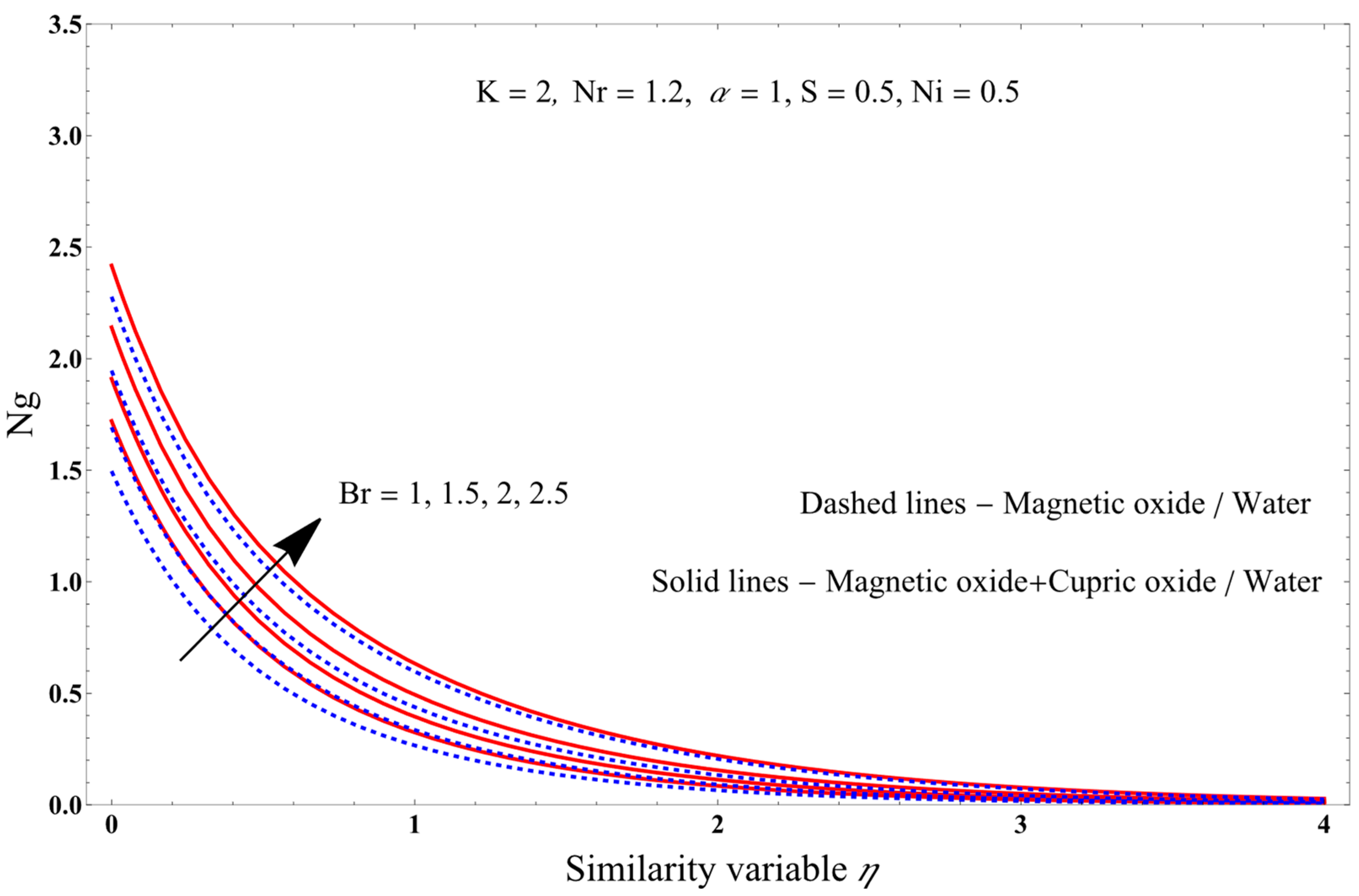
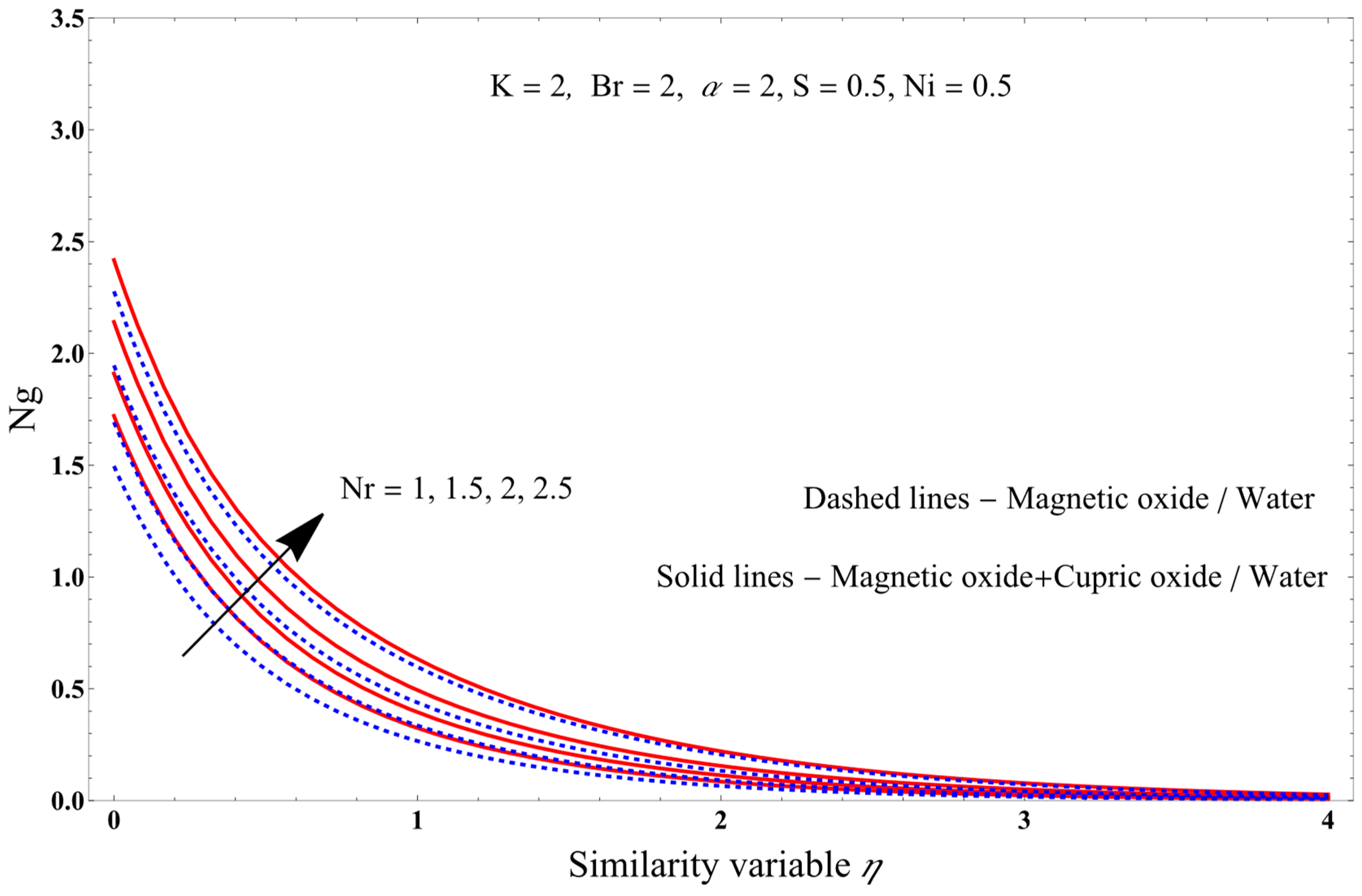


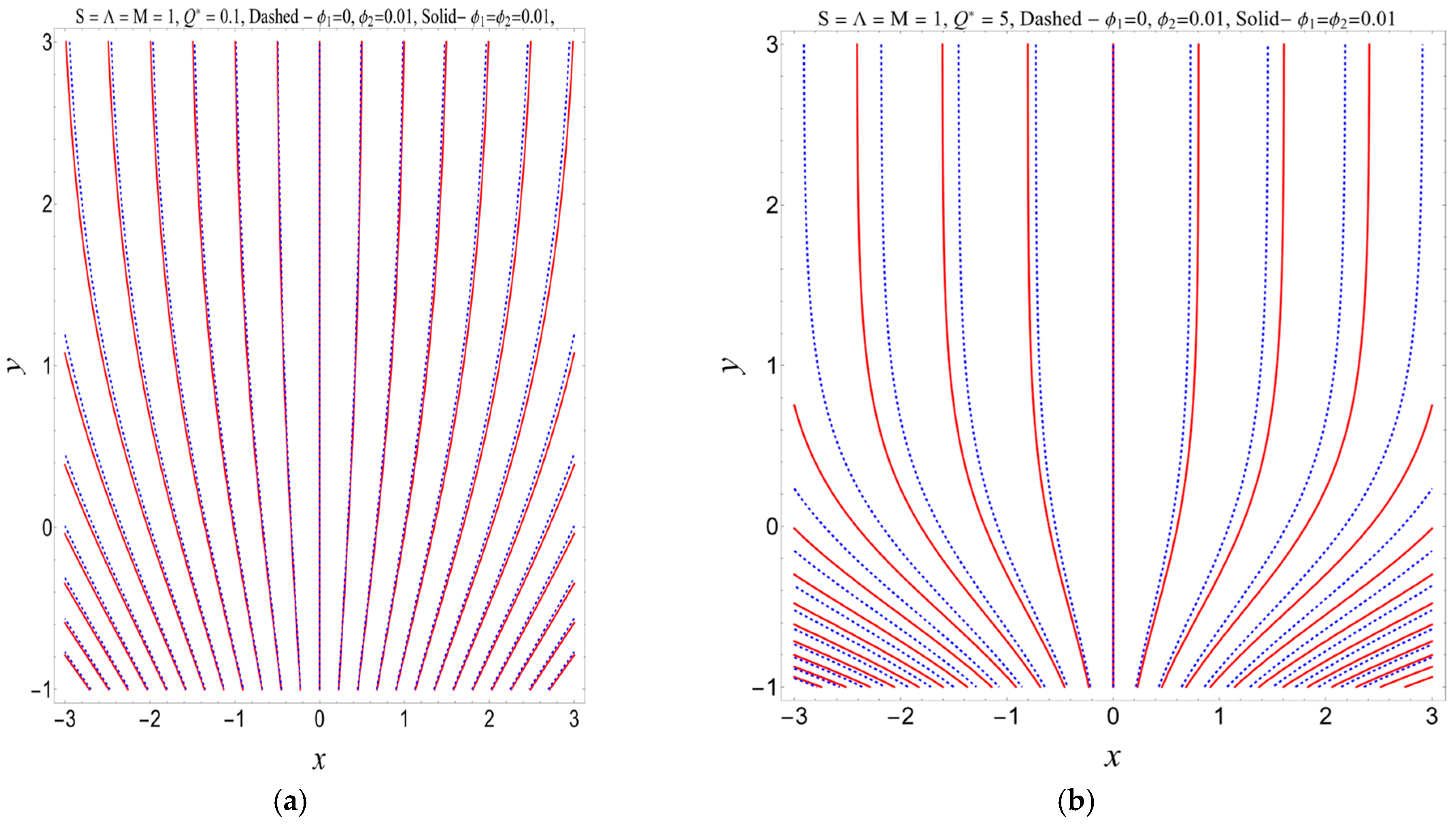
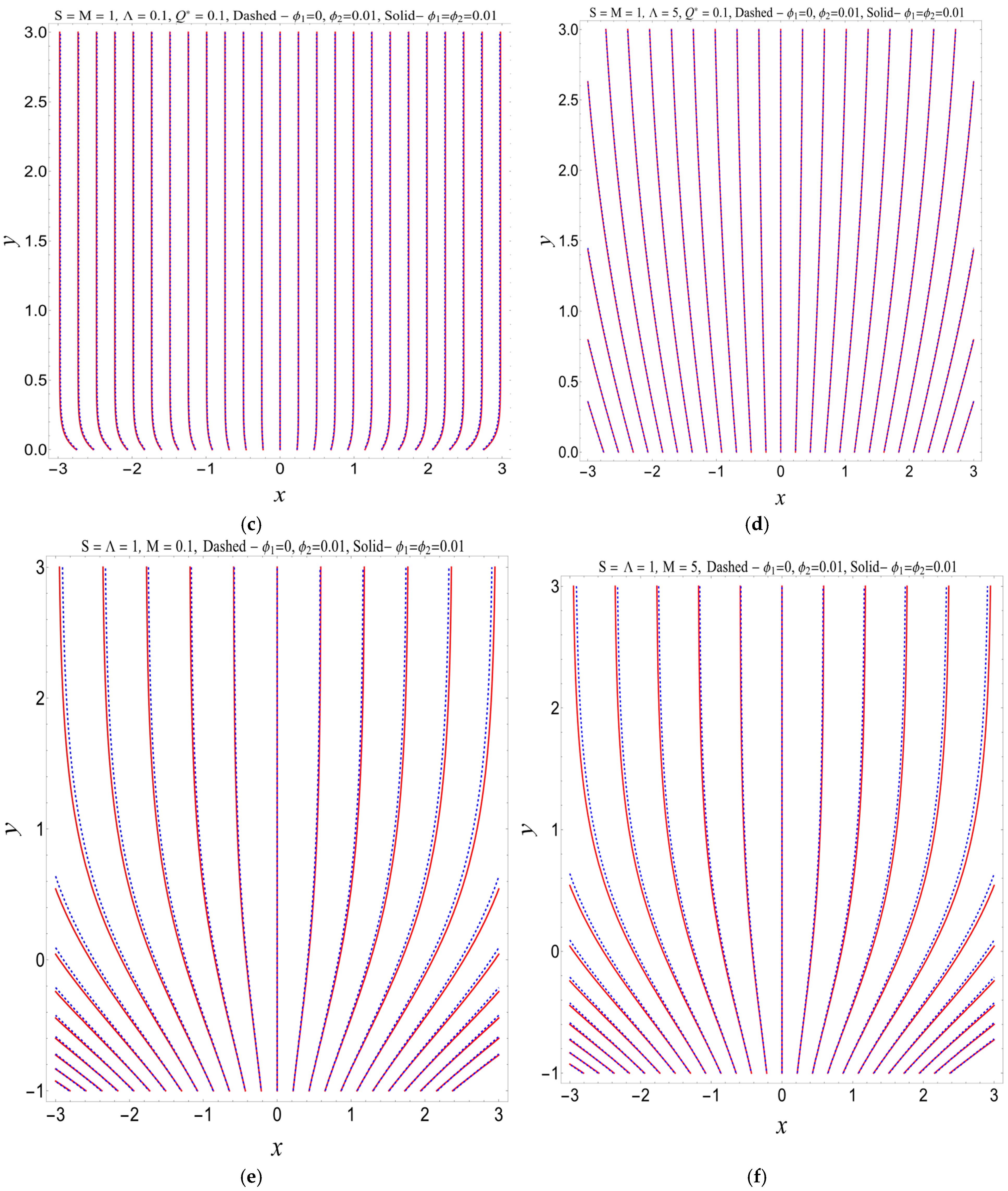
| Characteristics of HNFs |
|---|
| Heat capacity , |
| Density , |
| Dynamic viscosity , |
| Thermal conductivity , |
| Electrical conductivity , |
| Properties | H2O (Water) | Fe3O4 (Magnetic Oxide) | CuO (Copper Oxide) |
|---|---|---|---|
| 5.5 × 10−6 | 2.5 × 104 | 6.9 × 10−2 | |
| 997.1 | 5180 | 6510 | |
| 4179 | 670 | 540 | |
| 0.613 | 9.7 | 18 |
Disclaimer/Publisher’s Note: The statements, opinions and data contained in all publications are solely those of the individual author(s) and contributor(s) and not of MDPI and/or the editor(s). MDPI and/or the editor(s) disclaim responsibility for any injury to people or property resulting from any ideas, methods, instructions or products referred to in the content. |
© 2024 by the authors. Licensee MDPI, Basel, Switzerland. This article is an open access article distributed under the terms and conditions of the Creative Commons Attribution (CC BY) license (https://creativecommons.org/licenses/by/4.0/).
Share and Cite
Sachhin, S.M.; Ankitha, P.K.; Sachin, G.M.; Mahabaleshwar, U.S.; Shevchuk, I.V.; Nayakar, S.N.R.; Kadli, R. Chemically Reactive Micropolar Hybrid Nanofluid Flow over a Porous Surface in the Presence of an Inclined Magnetic Field and Radiation with Entropy Generation. Physics 2024, 6, 1315-1344. https://doi.org/10.3390/physics6040082
Sachhin SM, Ankitha PK, Sachin GM, Mahabaleshwar US, Shevchuk IV, Nayakar SNR, Kadli R. Chemically Reactive Micropolar Hybrid Nanofluid Flow over a Porous Surface in the Presence of an Inclined Magnetic Field and Radiation with Entropy Generation. Physics. 2024; 6(4):1315-1344. https://doi.org/10.3390/physics6040082
Chicago/Turabian StyleSachhin, Sudha Mahanthesh, Parashurampura Karibasavanaika Ankitha, Gadhigeppa Myacher Sachin, Ulavathi Shettar Mahabaleshwar, Igor Vladimirovich Shevchuk, Sunnapagutta Narasimhappa Ravichandra Nayakar, and Rachappa Kadli. 2024. "Chemically Reactive Micropolar Hybrid Nanofluid Flow over a Porous Surface in the Presence of an Inclined Magnetic Field and Radiation with Entropy Generation" Physics 6, no. 4: 1315-1344. https://doi.org/10.3390/physics6040082
APA StyleSachhin, S. M., Ankitha, P. K., Sachin, G. M., Mahabaleshwar, U. S., Shevchuk, I. V., Nayakar, S. N. R., & Kadli, R. (2024). Chemically Reactive Micropolar Hybrid Nanofluid Flow over a Porous Surface in the Presence of an Inclined Magnetic Field and Radiation with Entropy Generation. Physics, 6(4), 1315-1344. https://doi.org/10.3390/physics6040082






